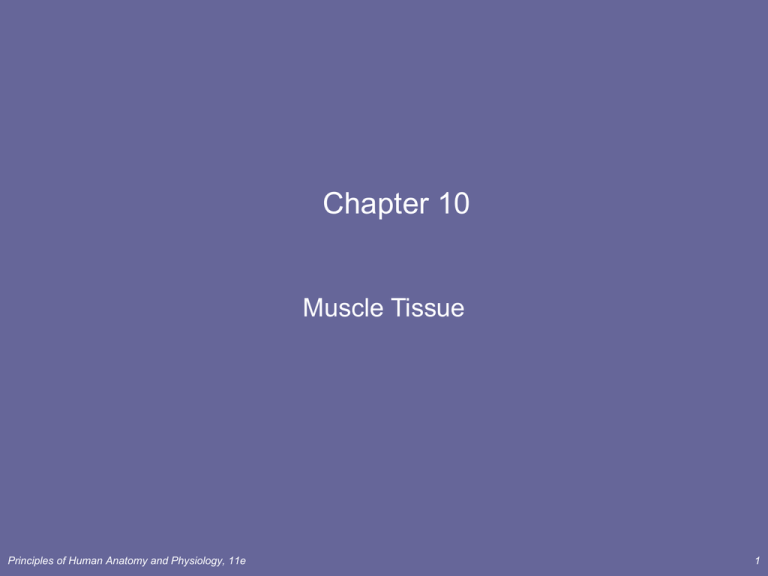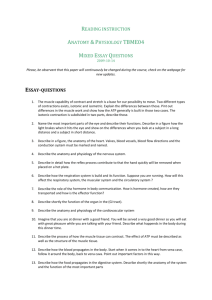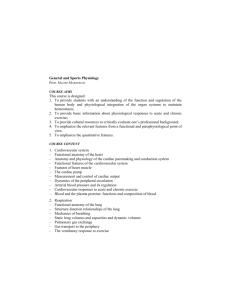Chapter 3
advertisement

Chapter 10 Muscle Tissue Principles of Human Anatomy and Physiology, 11e 1 Chapter 10 Muscle Tissue • Alternating contraction and relaxation of cells • Chemical energy changed into mechanical energy Principles of Human Anatomy and Physiology, 11e 2 OVERVIEW OF MUSCLE TISSUE • Types of Muscle Tissue • Skeletal muscle tissue is primarily attached to bones. It is striated and voluntary. • Cardiac muscle tissue forms the wall of the heart. It is striated and involuntary. • Smooth (visceral) muscle tissue is located in viscera. It is nonstraited (smooth) and involuntary. • Table 4.4 compares the different types of muscle. Principles of Human Anatomy and Physiology, 11e 3 3 Types of Muscle Tissue • Skeletal muscle – attaches to bone, skin or fascia – striated with light & dark bands visible with scope – voluntary control of contraction & relaxation Principles of Human Anatomy and Physiology, 11e 4 3 Types of Muscle Tissue • Cardiac muscle – striated in appearance – involuntary control – autorhythmic because of built in pacemaker Principles of Human Anatomy and Physiology, 11e 5 3 Types of Muscle Tissue • Smooth muscle – attached to hair follicles in skin – in walls of hollow organs -- blood vessels & GI – nonstriated in appearance – involuntary Principles of Human Anatomy and Physiology, 11e 6 Properties of Muscle Tissue • Excitability – respond to chemicals released from nerve cells • Conductivity – ability to propagate electrical signals over membrane • Contractility – ability to shorten and generate force • Extensibility – ability to be stretched without damaging the tissue • Elasticity – ability to return to original shape after being stretched Principles of Human Anatomy and Physiology, 11e 7 Skeletal Muscle -- Connective Tissue • Connective tissue components of the muscle include – epimysium = surrounds the whole muscle – perimysium = surrounds bundles (fascicles) of 10-100 muscle cells – endomysium = separates individual muscle cells Principles of Human Anatomy and Physiology, 11e 8 Connective Tissue Components Principles of Human Anatomy and Physiology, 11e 9 Sarcolemma, T Tubules, and Sarcoplasm • Skeletal muscle consists of fibers (cells) covered by a sarcolemma (Figure 10.3b). – The fibers contain T tubules and sarcoplasm – T tubules are tiny invaginations of the sarcolemma that quickly spread the muscle action potential to all parts of the muscle fiber. • Sarcoplasm is the muscle cell cytoplasm and contains a large amount of glycogen for energy production and myoglobin for oxygen storage. Principles of Human Anatomy and Physiology, 11e 10 Transverse Tubules • T (transverse) tubules are invaginations of the sarcolemma into the center of the cell – filled with extracellular fluid – carry muscle action potentials down into cell • Mitochondria lie in rows throughout the cell – near the muscle proteins that use ATP during contraction Principles of Human Anatomy and Physiology, 11e 11 Sarcoplasmic Reticulum (SR) • System of tubular sacs similar to smooth ER in nonmuscle cells • Stores Ca+2 in a relaxed muscle • Release of Ca+2 triggers muscle contraction Principles of Human Anatomy and Physiology, 11e 12 Filaments and the Sarcomere • Thick and thin filaments overlap each other in a pattern that creates striations (light I bands and dark A bands) • The I band region contains only thin filaments. • They are arranged in compartments called sarcomeres, separated by Z discs. • In the overlap region, six thin filaments surround each thick filament Principles of Human Anatomy and Physiology, 11e 13 Thick & Thin Myofilaments Overlap Dark(A) & light(I) bands (electron microscope) Principles of Human Anatomy and Physiology, 11e 14 The Proteins of Muscle -- Myosin • Thick filaments are composed of myosin – each molecule resembles two golf clubs twisted together – myosin heads (cross bridges) extend toward the thin filaments • Held in place by the M line proteins. Principles of Human Anatomy and Physiology, 11e 15 The Proteins of Muscle -- Actin • Thin filaments are made of actin, troponin, & tropomyosin • The myosin-binding site on each actin molecule is covered by tropomyosin in relaxed muscle • The thin filaments are held in place by Z lines. From one Z line to the next is a sarcomere. Principles of Human Anatomy and Physiology, 11e 16 Sliding Filament Mechanism Of Contraction • Myosin cross bridges pull on thin filaments • Thin filaments slide inward • Z Discs come toward each other • Sarcomeres shorten.The muscle fiber shortens. The muscle shortens • Notice :Thick & thin filaments do not change in length Principles of Human Anatomy and Physiology, 11e 17 Overview: From Start to Finish Basic Structures • Nerve ending • Neurotransmitter • Muscle membrane • Stored Ca+2 • ATP • Muscle proteins Principles of Human Anatomy and Physiology, 11e 18 How Does Contraction Begin? 1. Nerve impulse reaches an axon terminal & synaptic vesicles release acetylcholine (ACh) 2. ACh diffuses to receptors on the sarcolemma & Na+ channels open and Na+ rushes into the cell 3. A muscle action potential spreads over sarcolemma and down into the transverse tubules 4. SR releases Ca+2 into the sarcoplasm 5. Ca+2 binds to troponin & causes troponin-tropomyosin complex to move & reveal myosin binding sites on actin--the contraction cycle begins Principles of Human Anatomy and Physiology, 11e 19 Contraction Cycle • Repeating sequence of events that cause the thick & thin filaments to move past each other. • 4 steps to contraction cycle – ATP hydrolysis – attachment of myosin to actin to form crossbridges – power stroke – detachment of myosin from actin • Cycle keeps repeating as long as there is ATP available & there is a high Ca+2 level near the filaments. Principles of Human Anatomy and Physiology, 11e 20 Steps in the Contraction Cycle • Notice how the myosin head attaches and pulls on the thin filament with the energy released from ATP Principles of Human Anatomy and Physiology, 11e 21 ATP and Myosin • • • • • • Myosin heads are activated by ATP Activated heads attach to actin & pull (power stroke) ADP is released. (ATP released P & ADP & energy) Thin filaments slide past the thick filaments ATP binds to myosin head & detaches it from actin All of these steps repeat over and over – if ATP is available & – Ca+ level near the troponin-tropomyosin complex is high Principles of Human Anatomy and Physiology, 11e 22 Rigor Mortis • Rigor mortis is a state of muscular rigidity that begins 3-4 hours after death and lasts about 24 hours • After death, Ca+2 ions leak out of the SR and allow myosin heads to bind to actin • Since ATP synthesis has ceased, crossbridges cannot detach from actin until proteolytic enzymes begin to digest the decomposing cells. Principles of Human Anatomy and Physiology, 11e 23 Excitation - Contraction Coupling • All the steps that occur from the muscle action potential reaching the T tubule to contraction of the muscle fiber. Principles of Human Anatomy and Physiology, 11e 24 Structures of NMJ Region • Synaptic end bulbs are swellings of axon terminals • End bulbs contain synaptic vesicles filled with acetylcholine (ACh) • Motor end plate membrane contains 30 million ACh receptors. Principles of Human Anatomy and Physiology, 11e 25 Neuromuscular Junction (NMJ) or Synapse • NMJ = myoneural junction – end of axon nears the surface of a muscle fiber at its motor end plate region (remain separated by synaptic cleft or gap) Principles of Human Anatomy and Physiology, 11e 26 Relaxation • Acetylcholinesterase (AChE) breaks down ACh within the synaptic cleft • Muscle action potential ceases • Ca+2 release channels close • Active transport pumps Ca2+ back into storage in the sarcoplasmic reticulum • Calcium-binding protein (calsequestrin) helps hold Ca+2 in SR (Ca+2 concentration 10,000 times higher than in cytosol) • Tropomyosin-troponin complex recovers binding site on the actin Principles of Human Anatomy and Physiology, 11e 27 Overview: From Start to Finish • • • • • • Principles of Human Anatomy and Physiology, 11e Nerve ending Neurotransmittor Muscle membrane Stored Ca+2 ATP Muscle proteins 28 Length-Tension Relationship • The forcefulness of muscle contraction depends on the length of the sarcomeres within a muscle before contraction begins. • Figure 10.10 plots the length-tension relationships for skeletal muscle. Principles of Human Anatomy and Physiology, 11e 29 Length Tension Curve • Graph of Force of contraction (Tension) versus Length of sarcomere • Optimal overlap at the top of the graph • When the cell is too stretched and little force is produced • When the cell is too short, again little force is produced Principles of Human Anatomy and Physiology, 11e 30 Pharmacology of the NMJ • Botulinum toxin blocks release of neurotransmitter at the NMJ so muscle contraction can not occur – bacteria found in improperly canned food – death occurs from paralysis of the diaphragm • Curare (plant poison from poison arrows) – causes muscle paralysis by blocking the ACh receptors – used to relax muscle during surgery Principles of Human Anatomy and Physiology, 11e 31 Muscle Metabolism Production of ATP in Muscle Fibers • Muscle uses ATP at a great rate when active • Sarcoplasmic ATP only lasts for few seconds • 3 sources of ATP production within muscle – creatine phosphate – anaerobic cellular respiration – aerobic cellular respiration Principles of Human Anatomy and Physiology, 11e 32 MUSCLE METABOLISM • Creatine phosphate and ATP can power maximal muscle contraction for about 15 seconds and is used for maximal short bursts of energy (e.g., 100-meter dash) (Figure 10.13a). – Creatine phosphate is unique to muscle fibers. Principles of Human Anatomy and Physiology, 11e 33 Creatine Phosphate: Details • Excess ATP within resting muscle used to form creatine phosphate • Creatine phosphate 3-6 times more plentiful than ATP within muscle • Its quick breakdown provides energy for creation of ATP • Sustains maximal contraction for 15 sec (used for 100 meter dash). • Athletes tried creatine supplementation – gain muscle mass but shut down bodies own synthesis (safety?) Principles of Human Anatomy and Physiology, 11e 34 MUSCLE METABOLISM • The partial catabolism of glucose to generate ATP occurs in anaerobic cellular respiration (Figure 10.13b). This system can provide enough energy for about 30-40 seconds of maximal muscle activity (e.g., 300-meter race). • Muscular activity lasting more than 30 seconds depends increasingly on aerobic cellular respiration (reactions requiring oxygen). This system of ATP production involves the complete oxidation of glucose via cellular respiration (biological oxidation) (Figure 10.13c). Principles of Human Anatomy and Physiology, 11e 35 Muscle Fatigue • Inability to contract after prolonged activity • Factors that contribute to fatigue – central fatigue is feeling of tiredness and a desire to stop (protective mechanism) – insufficient release of acetylcholine from motor neurons – depletion of creatine phosphate – decline of Ca+2 within the sarcoplasm – insufficient oxygen or glycogen – buildup of lactic acid and ADP Principles of Human Anatomy and Physiology, 11e 36 The Motor Unit • Motor unit = one somatic motor neuron & all the skeletal muscle cells (fibers) it stimulates (10 cells to 2,000 cells) – muscle fibers normally scattered throughout belly of muscle • Total strength of a contraction depends on how many motor units are activated & how large the motor units are Principles of Human Anatomy and Physiology, 11e 37 Parts of a Twitch Contraction • Latent Period--2msec – Ca+2 is being released from SR – slack is being removed from elastic components • Contraction Period – 10 to 100 msec – filaments slide past each other • Relaxation Period – 10 to 100 msec – active transport of Ca+2 into SR • Refractory Period – muscle can not respond and has lost its excitability – 5 msec for skeletal & 300 msec for cardiac muscle Principles of Human Anatomy and Physiology, 11e 38 Wave Summation • If second stimulation applied after the refractory period but before complete muscle relaxation---second contraction is stronger than first Principles of Human Anatomy and Physiology, 11e 39 Complete and Incomplete Tetanus • Unfused tetanus – if stimulate at 20-30 times/second, there will be only partial relaxation between stimuli • Fused tetanus – if stimulate at 80-100 times/second, a sustained contraction with no relaxation between stimuli will result Principles of Human Anatomy and Physiology, 11e 40 Muscle Tone • Involuntary contraction of a small number of motor units (alternately active and inactive in a constantly shifting pattern) – keeps muscles firm even though relaxed – does not produce movement • Essential for maintaining posture (head upright) • Important in maintaining blood pressure – tone of smooth muscles in walls of blood vessels Principles of Human Anatomy and Physiology, 11e 41 Isotonic and Isometric Contraction • Isotonic contractions = a load is moved – concentric contraction = a muscle shortens to produce force and movement – eccentric contractions = a muscle lengthens while maintaining force and movement • Isometric contraction = no movement occurs – tension is generated without muscle shortening – maintaining posture & supports objects in a fixed position Principles of Human Anatomy and Physiology, 11e 42 Classification of Muscle Fibers • Slow oxidative (slow-twitch) – red in color (lots of mitochondria, myoglobin & blood vessels) – prolonged, sustained contractions for maintaining posture • Oxidative-glycolytic (fast-twitch A) – red in color (lots of mitochondria, myoglobin & blood vessels) – split ATP at very fast rate; used for walking and sprinting • Fast glycolytic (fast-twitch B) – white in color (few mitochondria & BV, low myoglobin) – anaerobic movements for short duration; used for weight-lifting Principles of Human Anatomy and Physiology, 11e 43 Fiber Types within a Whole Muscle • Most muscles contain a mixture of all three fiber types • Proportions vary with the usual action of the muscle – neck, back and leg muscles have a higher proportion of postural, slow oxidative fibers – shoulder and arm muscles have a higher proportion of fast glycolytic fibers • All fibers of any one motor unit are same. • Different fibers are recruited as needed. Principles of Human Anatomy and Physiology, 11e 44 Regeneration of Muscle • Skeletal muscle fibers cannot divide after 1st year – growth is enlargement of existing cells – repair • bone marrow produce some new cells • if not enough numbers---fibrosis occurs most often • Cardiac muscle fibers cannot divide or regenerate – all healing is done by fibrosis (scar formation) • Smooth muscle fibers (regeneration is possible) – cells can grow in size (hypertrophy) – some cells (uterus) can divide (hyperplasia) – new fibers can form from stem cells in BV walls Principles of Human Anatomy and Physiology, 11e 45 Aging and Muscle Tissue • Skeletal muscle starts to be replaced by fat beginning at 30 – “use it or lose it” • Slowing of reflexes & decrease in maximal strength Principles of Human Anatomy and Physiology, 11e 46 Myasthenia Gravis • Progressive autoimmune disorder that blocks the ACh receptors at the neuromuscular junction • The more receptors are damaged the weaker the muscle. • More common in women 20 to 40 with possible line to thymus gland tumors • Begins with double vision & swallowing difficulties & progresses to paralysis of respiratory muscles • Treatment includes steroids that reduce antibodies that bind to ACh receptors and inhibitors of acetylcholinesterase Principles of Human Anatomy and Physiology, 11e 47 Muscular Dystrophies • Inherited, muscle-destroying diseases • Sarcolemma tears during muscle contraction • Mutated gene is on X chromosome so problem is with males almost exclusively • Appears by age 5 in males and by 12 may be unable to walk • Degeneration of individual muscle fibers produces atrophy of the skeletal muscle • Gene therapy is hoped for with the most common form = Duchenne muscular dystrophy Principles of Human Anatomy and Physiology, 11e 48 Abnormal Contractions • Spasm = involuntary contraction of single muscle • Cramp = a painful spasm • Tic = involuntary twitching of muscles normally under voluntary control--eyelid or facial muscles • Tremor = rhythmic, involuntary contraction of opposing muscle groups Principles of Human Anatomy and Physiology, 11e 49 Atrophy and Hypertrophy • Atrophy – wasting away of muscles – caused by disuse (disuse atrophy) or severing of the nerve supply (denervation atrophy) – the transition to connective tissue can not be reversed • Hypertrophy – increase in the diameter of muscle fibers – resulting from very forceful, repetitive muscular activity and an increase in myofibrils, SR & mitochondria Principles of Human Anatomy and Physiology, 11e 50





